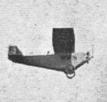The second machine exhibited by the Caspar Werke is a commercial monoplane of small capacity, the cabin being arranged to carry but two people, seated vis-A-vis one another in a very narrow cabin. This machine is known as the type C.L.E. II, and is fitted with a Siemens radial seven-cylinder engine of 80 h.p. Thus the power expenditure per paying passenger is but 40 h.p., which should be a good commercial proposition. If the machine is piloted by its owner, and used for touring with a couple of friends, so that it becomes legitimate to count in the pilot in the useful load, the economy becomes even greater, i.e., 26.7 h.p. per occupant. Thus, for use on feeder lines joining up with main air routes, on which there is insufficient traffic to make a larger machine pay, the Caspar C.L.E. II should be a very useful and economical little machine.
As cheapness of construction was one of the desiderata, and clean aerodynamic design another, Ingenieur von Loessl chose the cantilever monoplane type, but incorporated a fuselage composed entirely of straight lines and flat surfaces, which could be easily and cheaply covered with ply-wood panels. It is, of course, well known that these panels can be bent around a cylinder but not around a barrel, i.e., not around a double curvature. Nevertheless, if the panels can be used without bending, their application to the internal framework becomes so much easier. In the C.L.E. II the fuselage is of rectangular section, with an inverted V roof and a V bottom in the forward part. Aft of the undercarriage the bottom is flat.
The undercarriage is of the form first made popular by Dornier, i.e., the axle is enclosed in a casing of thick aerofoil section, and the rubber shock absorbers are attached to the ends of this, cantilever fashion, giving a wide wheel track.
The wing is in three sections, a large centre portion and two relatively small end pieces, attached to the main wing by special quick-release fittings. In the centre, above the " roof tree " of the fuselage, the wing is attached by simple hooks, and is braced farther out by struts sloping out at a fairly flat angle.
Behind the trailing edge of the wing is the pilot's cockpit, and immediately under the wing the tiny cabin with accommodation for two passengers. The space is rather cramped, especially as regards leg-room, and also to a certain extent as regards head-room. One passenger faces aft and the other forward, and the cabin is of only sufficient width to give elbow space, and not much of that if the passengers be Germans of average, bulk. As in the case of the biplane, the monoplane is covered entirely with three-ply, and it was noticed that in the bottom of the fuselage there were no diagonal members to stiffen the ply, which was not more than 1 or 1,5 mm. thick.
The main characteristics of the Caspar C.L.E. II are as follows : Weight, empty, 450 kg. (1,000 lbs.) ; useful load, 360 kg. (790 lbs.) ; total loaded weight, 810 kg. (1,790 lbs.). The maximum speed is 160 km. (100 m.p.h.), and the landing speed 80 km. (50 m.p.h.). The range is approximately800 km. (500 miles).

| Type |
1 + 2-seat passenger plane |
| Engine |
1 Siemens Sh 5 |
| Dimensions |
Length 6.72 m, height 2.20 m, span 12.00 m, wing area 19.00 m2 |
| Weights |
Empty 450 kg, fuel 83 kg, oil 8 kg, crew 80 kg, payload 209 kg, flying weight 830 kg |
| Performance |
Max. speed at sea level 160 km/h, cruising speed at sea level 145 km/h, climb 2.10 m7sec., service ceiling 3000 m, range 800 km, max. endurance 6.0 h, landing speed 65 km/h |
| Type |
Werk.Nr |
Registration |
History |
|
|
D-294 |
Built in 1923. Took part in the International Air Exhibition in Gothenburg (Sweden) in July 1923. Static and also performed some flights. |


Typ CLE 11 der Caspar-Werke.
Die Maschine ist als Zubringerflugzeug [ür 2 Fluggäste zur Benutzung auf weniger besuchten Linien gedacht. Bei der Konstruktion wurde besonders auf Wirtschaftlichkeit und
Betriebssicherheit Gewicht gelegt.
Um kleine Herstellungskosten zu erreichen., wurde eine möglichst gerade Linienführung angewandt. Der Rumpf ist als ein mit Holzbeplankung versehenes Fachwerk
aufgebaut; der Flügel, 4 Baldachinstreben mit dem Rumpf verbunden, ist freitragend, zum Aufnehmen der Stirndrücke und andere horizontale Kräfte dienen die in der Mitte
angebrachten Gleitbeschläge. Besonders hervorzuheben sind das gute Seitenverhältnis, auch beim Leitwerk, verhältnismäßig hohe Leistungsbelastung (10,375 kg/PS) und
Vermeidung jedes herausragenden Teils, welcher überflüssigen Luftwiderstand veranlassen könnte. Dadurch, daß die hölzerne Außenhaut des Flügels, wie dies durch die
früheren Versuche der Firma einwandfrei bewiesen wurde, die Belastung mitträgt, konnte das Flügelgerippe trotz der verhältnismäßig großen Spannweite sehr leicht gehalten
werden.
Sehr interessant ist die konstruktive Ausbildung der Schnellverschlüsse zur0,Befestigung der Flügelenden, deren Konstruktion aus den nebenst. Abb. ersichtlich ist. Der 80 PS
Siemens-Sternmotor ist auf einem ausklappbaren Motorschild befestigt so, daß der Motor vor und nach jedem Flug leicht nachzusehen und auszutauschen ist. Zwischen dem
Motor und der Kabine ist eine feuersichere Wand eingebaut.
Das kurze Fahrgestell sitzt direkt unter dem Rumpf und ist mit einer! tragflügelartigen Bekleidung umgeben. Die Hauptdaten der Maschine sind folgende: Spannweite 12 m,
Flügeltiefe 1,6 m, größte Länge 6,65 m, größte Höhe 2,2 m, Motor 80 PS Siemens - Stern, luftgekühlt, Leergegewicht 450 kg, Zuladung 380 kg, Gesamtgewicht 830 kg,
Anzahl der Plätze: 1 Führer, 2 Passagiere, Geschwindigkeit,.!60 km/Std.



